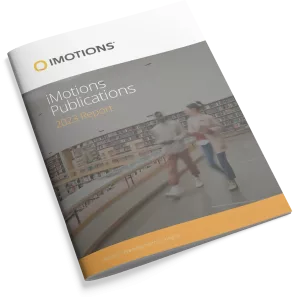-
The Effects of “Media Tech Neck”: The Impact of Spinal Flexion on Cognitive and Emotional Processing of Videos
Adoption of mobile devices (e.g., smart phones and tablets) has popularized a neck-down posture during media consumption that is different from the traditional upright body posture for video viewing. A neck-down posture exerts substantial pressure upon the spine, and this posture has been previously linked to psychological effects. This study advances the literature by studying […]
-
Facial Expressions as an Index of Listening Difficulty and Emotional Response
Knowledge about listening difficulty experienced during a task can be used to better understand speech perception processes, to guide amplification outcomes, and can be used by individuals to decide whether to participate in communication. Another factor affecting these decisions is individuals’ emotional response which has not been measured objectively previously. In this study, we describe […]
-
Children and overtourism: a cognitive neuroscience experiment to reflect on exposure and behavioural consequences
As tourism research has paid limited attention to children, this study investigates children’s reactions to tourism development, focusing on their unique viewpoints on the World Heritage Site of Dubrovnik, Croatia. It employed cognitive neuroscience methods with 397 participants, revealing that, despite their preference for sustainable tourism scenarios, children exhibit a notable fixation on images emblematic […]
-
Associations between emotions and psychophysiological states and confirmation bias in question formulation in ongoing simulated investigative interviews of child sexual abuse
Introduction: In forensic settings interviewers are advised to ask as many open-ended questions as possible. However, even experts may have difficulty following this advice potentially negatively impacting an investigation. Here, we sought to investigate how emotions and psychophysiological parameters are associated with question formulation in real time in an ongoing (simulated) child sexual abuse (CSA) interview. […]
-
The influence of negative emotions on brand trust and intention to share cause-related posts: A neuroscientific study
Negative user-generated content provides cues that warn other consumers to avoid using a particular product or service. This study explores whether brand feedback can counteract consumer backlash to a given company’s cause-related marketing, with a particular focus on how visual attention can moderate negative emotions. Hypotheses based on the Appraisal-Tendency Framework and commitment-trust theory were […]
-
The neurophysiological mechanisms underlying brand personality consumer attraction: EEG and GSR evidence
The “similarity-attraction” mechanism of brand personality exists in a state of controversy because many studies have found that the brand personality favored by consumers is inconsistent with their personality. The psychological reasons underlying this paradoxical situation remain unknown. Therefore, based on the circumplex model of emotion theory in neuroscience, this study uses EEG and GSR […]
-
Experimental Setup and Protocol for Creating an EEG-signal Database for Emotion Analysis Using Virtual Reality Scenarios
Automatic emotion recognition systems aim to identify human emotions from physiological signals, voice, facial expression or even physical activity. Among these types of signals, the usefulness of signals from electroencephalography (EEG) should be highlighted. However, there are few publicly accessible EEG databases in which the induction of emotions is performed through virtual reality (VR) scenarios. […]
-
Analyzing motivating functions of consumer behavior: Evidence from attention and neural responses to choices and consumption
Academia and business have shown an increased interest in using neurophysiological methods, such as eye-tracking and electroencephalography (EEG), to assess consumer motivation. The current research contributes to this literature by verifying whether these methods can predict the effects of antecedent events as motivating functions of attention, neural responses, choice, and consumption. Antecedent motivational factors are […]
-
Emerging biometric methodologies for human behaviour measurement in applied sensory and consumer science
This chapter covers some of the most popular emerging technologies used for measuring human behaviour in applied sensory and consumer science. Here, we focus on eye-tracking (ET) technology, electrodermal activity (EDA) or skin conductance, facial expression analysis (FEA) and electroencephalography (EEG), all of which can be employed to explore the underlying and at times unconscious […]
-
The effects of expressions of fear induced by background music on reading comprehension
Research has suggested that background music can have a positive or negative effect that can influence the affective state of individuals. Although research has demonstrated that fear negatively influences our cognitive performance, there is a research gap in understanding the combined effects of different background music tempo and fear in influencing reading comprehension performance. Data […]
Research Report 2023
In-depth look at the scientific landscape as powered by iMotions software, showcasing groundbreaking research and the impact of our tools in various scientific and industrial fields.

Share Your Research

850+ universities worldwide with an iMotions human behavior lab
73 of the top 100 highest ranked universities
710+ published research papers using iMotions
iMotions is used for some of the most interesting human behavior research studies carried out by top researchers around the world. Contact us to have your publication featured here.
The authors of these publications have used iMotions as a software tool within their research.
“Software should be cited on the same basis as any other research product such as a paper or a book; that is, authors should cite the appropriate set of software products just as they cite the appropriate set of papers” (Katz et al., 2020).
We therefore encourage you to cite the use of iMotions where appropriate.
How to cite iMotions
APA
iMotions (10), iMotions A/S, Copenhagen, Denmark, (2024).
Note: adjust the version and year where relevant.
5 Most Popular Blogs
Learn How to Conduct Human Behavior Research with iMotions
Publications
Read publications made possible with iMotions
Blog
Get inspired and learn more from our expert content writers
Newsletter
A monthly close up of latest product and research news





